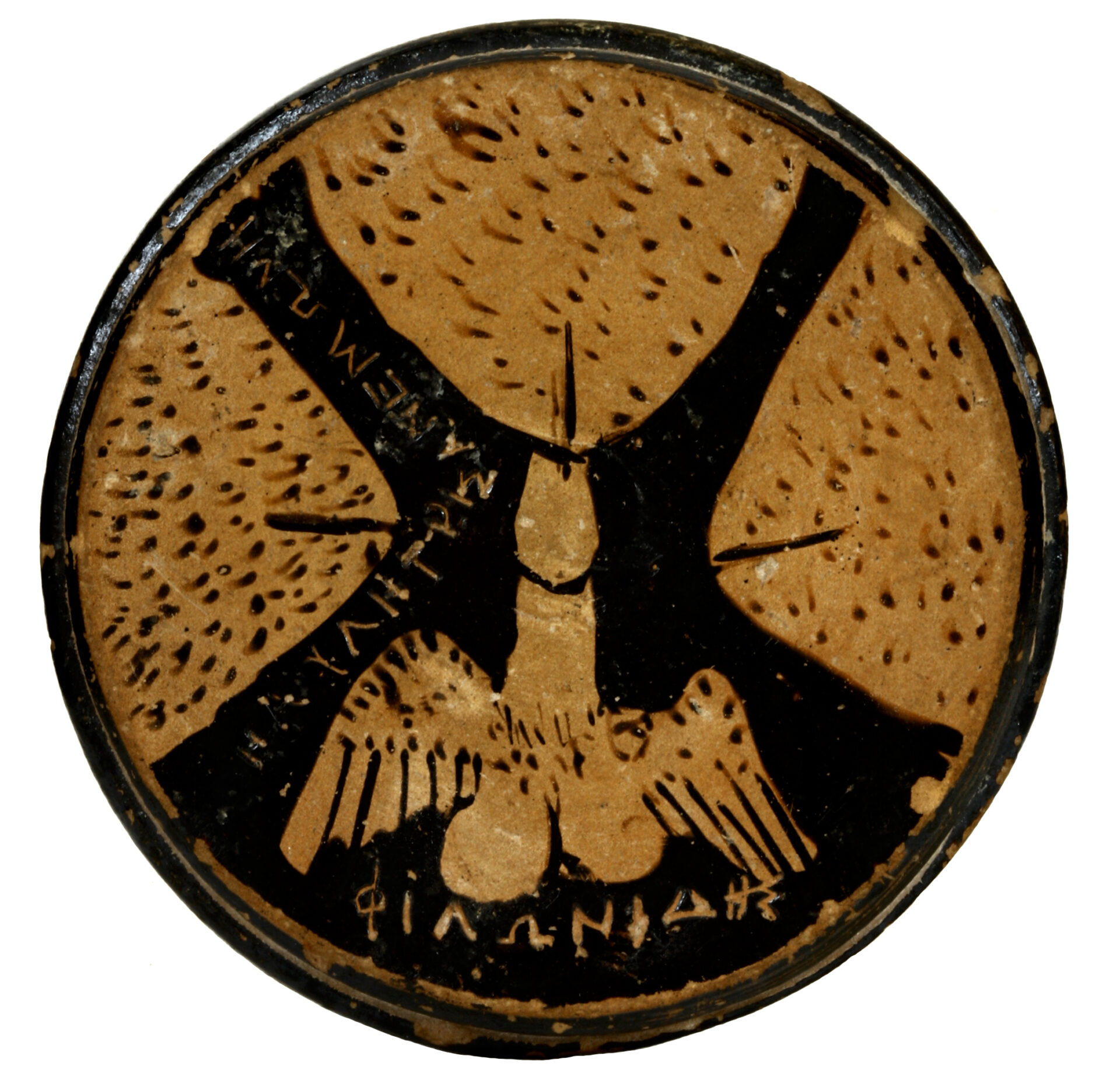Exhibit of the month
An “Unconventional” Judgement of Paris
Red-figure pyxis lid
National Archaeological Museum, inv. no. Α 2510
Provenance unknown
Measurements: Height 0,01 m., Diameter 0,045 m.
Date: around 430-420 B.C.
Exhibition area: Showcase 117, Room 55 of the Vases Collection
On a pyxis lid, a winged and fully erect phallus is depicted along with three vulvae, which are arranged on the circumference of the representation.
Incised under the phallus, in a particularly neat style, is the inscription Φιλωνίδης/Philonides[1]. Around the vulva on the left, in an equally neat manner, an inscription is engraved: ἡ αὐλητρὶς[2] ἀνεμώνη/ the female flutist anemone.
The careful, in Ionian alphabet, incising of the inscriptions before firing, but mainly the emphatic manner in which the name of Anemone is stated, allow us to reasonably assume that the engraver had in mind a specific girl flutist.
If the assumption that Anemone, this just once mentioned in the Attic portraiture figure, is a particular person is correct, then the same must be also valid for Philonides. This name is often encountered in ancient Athens. Possibly a certain «heartthrob» of the time known to the Athenians for his relationship with Anemone, or somebody else (could it be Philonides himself or a friend of his?) engraved the inscription on the lid of the pyxis, a vase that women were using for their beautification, in order to «publicize» his relationship with the renowned for her «services», female flutist.
In case that the above hypotheses are correct, then in the representation of the lid we can look for a phallic pun or comic comment, relating to Philonides and the girl flutist Anemone. Gaston Vorberg had, as a matter of fact, suggested that we are perhaps dealing with a parody of the Judgement of Paris! In antiquity the flying phallus held apotropaic, protective and magical properties, and it was attached to amulets to protect their possessors against the evil eye.
But also the name of Anemone[3] must not have been given accidentally to the girl flutist and probably refers to the short-lived as well as triste end of Aphrodite’s love affair with Adonis, her Syro-Phoenician mortal lover. According to the myth’s versions, of the Hellenistic (Bion of Smyrna – Epitaph of Adonis) and the early Imperial times (Ovid – Metamorphoses), anemones and roses sprang from the earth where the drops of Adonis’ blood fell merging with the tears of Aphrodite for the premature death of her beloved one.
Dr. George Kavvadias
[1] The Athenian comic poet Philonides, who flourished actually in the same period to which the lid is dated, is potentially identifiable with the Philonides of the inscription. It is recorded in the ancient sources that the comic poet Philonides, son of Nicochares from Kydathenaeon, was initially a γναφεύς/ [fuller] or γραφεύς/scribe. Then he became an actor of Aristophanes and a comic poet himself. Only a few titles of his comedies are known, (Κόθορνοι/The Cothurni/High boots, Ἀπήνη/Apene/The Chariot, Φιλέταιρος/ Philetairus/The Good Comrade, Προάγων/ Proagon-The Preliminary contest), of which just a small number of verses is preserved, as well as fragments from others.
[2] In ancient Athens the female flutists were slaves, who, apart from the required musical accompaniment, provided also sexual services for payment to the participants of the banquets. They belonged to the middle category of the priestesses of vulgar love, ranking between the δεικτηριάδες/ deikteriades (prostitutes inmates of brothels), namely low-level prostitutes, who worked in cheap brothels, the so-called δεικτήρια/ deikteria, and the lavishly compensated and emancipated hetaerae (courtesans). By law, the remuneration of the female flutists could not exceed two drachms, which the city taxed at the corresponding rate (πορνικὸν τέλος/ pornikon telos-tax paid by the brothel-keepers).
[3] The name of the girl flutist Anemone, possibly alludes to the Anemone of the myth. Indeed, anemones (flame Anemone, Anemone fulgens), which blossom and die rapidly, in the verdant and fragrant spring meadows, have a short life, exactly as Adonis did. Equally ephemeral and short-lived must have been the relationships of the flutist Anemone with her Athenian clients.
Selected bibliography:
BA 43665. Vorberg 1965, 131. Immerwahr 2009, cat. no. 857.
Dierichs 2008, 49-50 fig. 37 (who erroneously thinks that the inscription of Anemone refers to two vulvae, the left and the middle one).
For the symbolism of the winged phallus, see Boardman 1992, 229, fig. 5 and Keuls 1993, 75-82.
For the names Anemone and Philonides, respectively, see LPGN, vol. ΙΙ, pp. 31 and 463.
For the comedian Philonides, see Kassel–Austin PCG, vol. VII, 363-369.
For the social position of girl flutists, see Dillon 2002, 183 and Lewis 2002, 95-98.
For the myth of Adonis and the philological sources, see Atallah 1966 and Detienne 1972.
For the Adonia in Athens, see Dillon 2002, 162-169.



